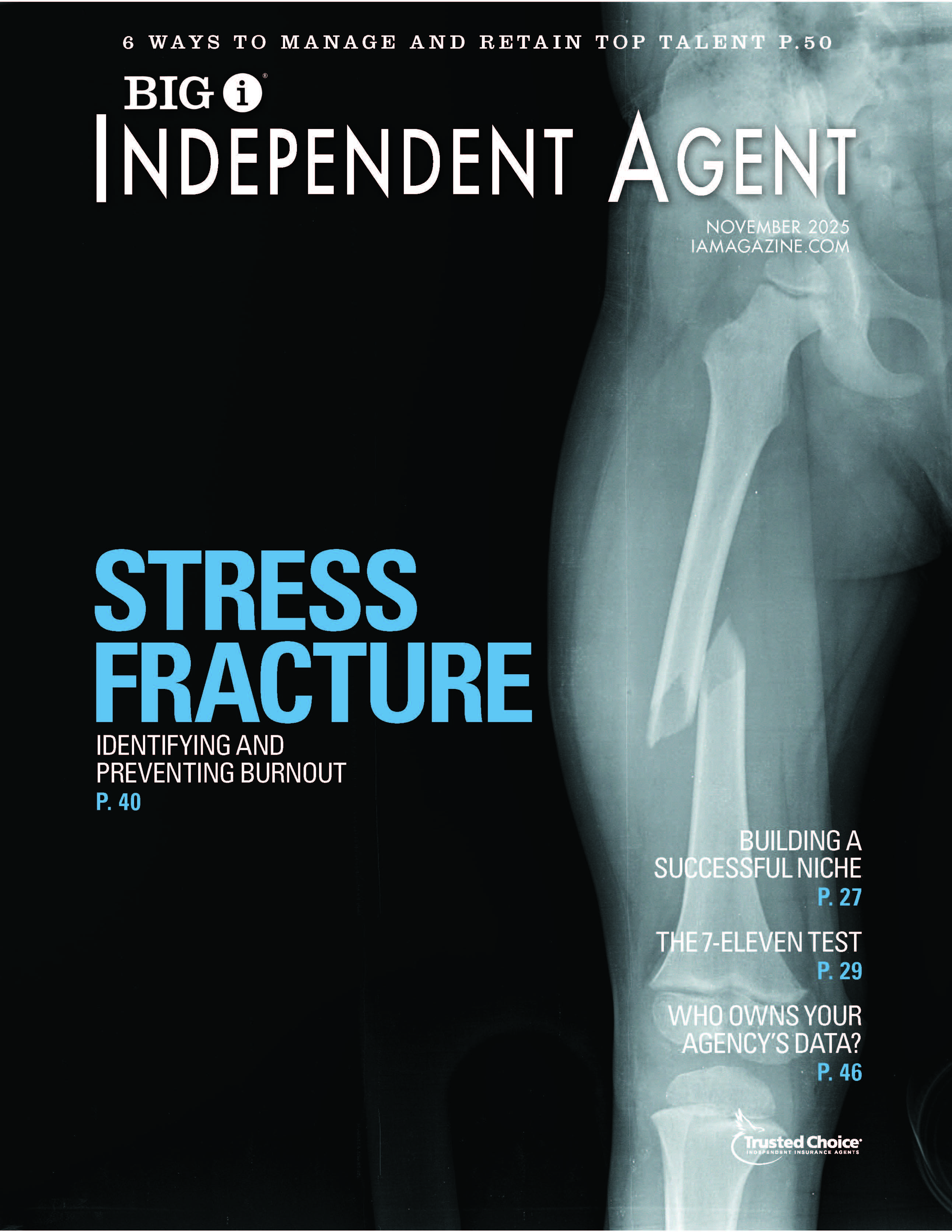The Fine Art of Book Balance
By: Susan Hodges
| August Felker doesn’t consider himself a book balancing believer. “Honestly, we don’t look at it that way,” says the CEO of The Murphy Insurance Group, a six-location firm based in Madison, Wis. “We look at each type of business differently, and we have different people feeding each one. We don’t really think about balance; we think more about how we can better excel in each division.” Felker is one of a small but growing number of agency principals who seek less to maintain specific ratios of one type of business to another, but to grow every line, every product and every service as much as possible. “I guess you’d balance your books of business if you fear that one market is going away,” Felker says. “But we feel great about commercial, about employee benefits and about personal lines. And we feel strongly that we can be successful in all three.” In an era of evolving health care markets, a soft economy and shifting carrier requirements, is the fine art of book balance still relevant? Or is it more important than ever? Stats Back a New BalanceFindings from two studies conducted by the Big “I,” one in association with Reagan Consulting (the 2012 Best Practices Study Update), the other with Future One (the 2012 Agency Universe Study), suggest that as an art, book-balancing is still alive and well. The balances are changing, however, the studies found, reflecting changes in U.S. health care laws and the national economy. “Balanced” agencies (in which neither personal nor commercial lines is dominant) are older, the Agency Universe Study found, on average 41 years old versus 27–31 years old for other groups. The theory: that balance “may help these agencies survive changing market conditions.” In contrast, the study found that 56% of agencies established in 2008 or later are personal-lines dominant. Whether this is because the sale of commercial coverage can require additional expertise such as risk management, or because personal lines rate-quoting technology is more advanced than that for commercial lines, is unclear. At the same time, however, the study found the proportion of large agencies that are commercial-lines dominant has decreased, from 57% in 2010 to 46% in 2012. “This may reflect large agencies’ increased use of direct-marketing techniques and telephone service to sell personal auto insurance,” according to the study. “Or it may reflect only the mix of offices responding to the survey.” The 2012 Best Practices Study Update showed agencies are branching out in revenue sources. The study found agencies with revenues of $2.5 million to $5 million reported income from sources other than property-casualty to include life insurance (27.2% at average agencies), disability coverage (20.8%) and dental and vision coverage (28.5%). Of total revenues reported by average agencies in this same category, commercial property-casualty sales accounted for nearly $2.2 million, while group life and health/financial products accounted for just greater than $470,000. Philosophy #1: Just Sell MoreAgents who size up the client relationships they’ve worked so to build (and then cross-sell, round out and fill in coverage gaps) are achieving volume and profits. Offering numerous types of insurance is still good business—but maintaining a strict balance among those types is becoming less important to some agencies as they bring employee benefits, life-health and retirement products into the mix. Jane Driscoll Henesey, CFO of Driscoll Insurance, a second-generation, family-owned agency in Norwell, Mass., is making investments across all lines of her business. “We’ve been in business [more than] 50 years and for the first time have hired a new producer for personal lines,” Henesey says. “We’re gearing it up, because selling personal lines to the owners of businesses we insure can be a very profitable part of our business—and if you’re servicing it the right way, it can be even more profitable.” Henesey has upgraded back-room processes and moved support staff around to better align tasks with talent and ability. “With the right processes in place and the right people doing the background work, your personal lines department can be very successful,” she says. “It can work hand-in-hand with your commercial accounts that want superior service because they’re VIPs on the commercial side, and they want the same treatment on the personal side.” Driscoll Insurance writes coverage for a lot of contractors and construction companies, the largest of which have in-office personnel to handle their insurance. “We find that these owners also have assistants who run their households and pay their personal bills,” says Henesey, “so it’s easier for them if they have [all of their insurance] under one roof. They want to be able to shoot off a short phone call or email and not be bothered with more.” Knowing that, Driscoll Insurance now offers clients a state registry service for automobiles. Says Henesey, “We’ll actually process the registrations as an extra service.” As CFO, Henesey could rattle off the percentage of agency business that each coverage line produces. But like Felker, Henesey focuses more on growth than on balance. Philosophy #2: Sell More—StrategicallyJeff Novak, on the other hand, believes book balancing is still important. The president of Advanced Insurance Designs, Inc., in Norton, Ohio, Novak purchased a property-casualty agency in October 2011to diversify his benefits firm. “We thought a lot about health care reform and potential changes that were coming,” Novak says. “We could see our commissions decreasing and our carriers paying us in new ways, and the possibility of our bonuses and overrides going away. We knew we needed to diversify into other lines of insurance.” To start, Novak and his executive team examined product lines they thought would be most compatible with their existing benefits business. Medicare supplements, property-casualty and other types of insurance were considered, but they deemed p-c the best fit. “We felt there was a nice cross between the benefits business and how a p-c operation could work in conjunction [with] our current client base,” Novak says. Novak and his partners were right: Acquisition of a well-respected nearby p-c agency brought expertise in both commercial and personal lines—and a bevy of new products as well. Today AIDI offers a full range of coverage in employee benefits; business insurance, including cyber liability and foreign liability; personal lines; Medicare supplements and annuities. The current balance between personal and commercial insurance at AIDI is about 50-50, but Novak plans to work toward a split that is 60% commercial and 40% personal. “We find personal lines to be extremely important, but our focus is a little more on the commercial side because we think our background in group health correlates with the commercial side of p-c,” says Novak. “Both types of insurance focus on working with employers, and we already have a lot of relationships with business owners.” Novak says AIDI already has growth in its p-c business, too. What the agency doesn’t have (but hopes to have by July) is a single agency management system to handle all of its business (see sidebar). “We’re currently using two different systems, one for benefits and one for property-casualty,” Novak says. “But we’re in the process of transitioning to a single system, and with all the headaches we’re going through now, we’re looking forward to that light at the end of the tunnel.” King of the Cross-SellCross-selling and account-rounding can be particularly beneficial to agencies with large commercial books. The reason: It’s easier for an agent with commercial expertise to write a personal policy than the other way around. “Businesses can be a playground for the sale of other insurance products if you already write commercial coverage, and a minefield if you don’t,” Bates says. For that reason, personal lines agencies wanting to write more commercial business might consider partnering with a commercial lines agency. “[Partnering] can be very successful,” says Bates. “Both agencies end up writing new coverage for friends instead of strangers.” But if your agency already has relationships with businesses, use them to open other doors. “Developing relationships is the hardest part of our business,” says The Murphy Insurance Group’s Felker. “It takes time and it’s expensive, so if you already have relationships with companies that think fondly of your agency, you have to build on them.” Felker is now seeing “a lot of growth” in employee benefits coming from commercial accounts with more than 50 workers. “Employee benefits is really changing,” he says. “I think you have to get to a certain scale to go after these accounts, but we feel like we’re there—and it seems like a great opportunity to go from [writing only] benefits to [writing] benefits and p-c.” Multilines agencies wanting to grow any book of business should have a process to cross-sell effectively, Felker says. “Regularly, once a month or once a quarter, you should know which lines your customers have bought from you and which they haven’t, and have a process for selling those lines. If you’re not doing this, you’re not making the most of your business.” Whether or not your agency maintains balance between books of business may boil down to your personal philosophy. But Felker has some simple advice: “In some areas you might be stronger than others, and you know you can’t be a one-stop shop. But your goal should always be to sell multiple products and services, and sell all of them as much as you can.” Susan Hodges is an IA senior contributing writer. | Find Book Gaps with TechnologyHeadaches can be expected when changing agency management systems. But Virginia Bates says payoff will be more than worth the pain. “Some agencies buy separate systems for their life and health business, but then they’re unable to identify cross-sell opportunities,” says Bates, president of VMB Associates, Inc., a Quincy, Mass.-based consultancy. Bates offers two steps agencies can take to identify coverage gaps among their books of business. “They can use their computer systems to conglomerate or cross-reference to show the various relationships between commercial p-c and benefits accounts,” she says. “They can also organize their policies by client instead of by type of business. In this way they can see all policies belonging to a client relationship—and at the same time, identify what’s missing.” Bates says agencies taking these steps often make powerful discoveries. “Many realize that writing the personal lines related to their commercial accounts could double their commission,” she says. But she disagrees with conventional wisdom that advocates relying on personal-lines downloads to track clients’ personal-lines coverage. “Different carriers download umbrellas to different places in your system,” she says. “So you end up having to go to several places in your system to find out who doesn’t have umbrella coverage.” —S.H. A Strong Case for BalanceThe Dowd Agencies have written personal insurance since opening in 1898. But over time, the sale of commercial insurance has surpassed personal to the point that commercial lines now accounts for more than 75% of business for this four-location firm based in Holyoke, Mass. It’s a situation that John Dowd, executive vice president, wants to change. “We’ve been through a couple of recessions where companies went out of business, shrank, got sold and so on, and when there’s that kind of contraction in the economy, you can watch your book shrink by quite a bit,” Dowd says. “We’ve always been very careful about how we manage our finances, and in a downturn, we don’t lay people off. If we’re more balanced between commercial and personal, closer to 50-50, we won’t feel a downturn quite so much.” To reach that balance quickly, The Dowd Agencies have purchased several small personal-lines agencies and are looking at acquiring another. “Our idea from a marketing standpoint is, any client who comes in the door to buy anything also becomes a prospect for our other two divisions,” says Dowd. “Our people are taught to identify those situations and cross-sell and up-sell. But you can only do so much of that. Then you have to work outside, and the acquisition route is the quickest way to go.” —S.H. |










